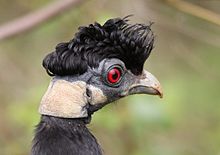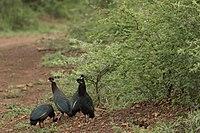| Crested guineafowl | |
|---|---|
 | |
.jpg) | |
| G. p. edouardi in Hluhluwe–iMfolozi Park, South Africa | |
| Scientific classification | |
| Kingdom: | Animalia |
| Phylum: | Chordata |
| Class: | Aves |
| Order: | Galliformes |
| Family: | Numididae |
| Genus: | Guttera |
| Species: | G. pucherani |
| Binomial name | |
| Guttera pucherani Hartlaub, 1860 | |
The crested guineafowl (Guttera pucherani) is a member of the Numididae, the guineafowl bird family. It is found in open forest, woodland and forest-savanna mosaics in Sub-Saharan Africa.
Description
It has a total length of approximately 50 cm (20 in) and weighs 721–1,543 g (1.590–3.402 lb).[2] The plumage is overall blackish with dense white spots. It has a distinctive black crest on the top of its head, the form of which varies from small curly feathers to down depending upon subspecies, and which easily separates it from all other species of guineafowl, except the plumed guineafowl. The names "crested" and "plumed" are often misapplied across the species.
Breeding
The species is monogamous with probable strong and long-lasting pair bonds. Courtship feeding is common, the author having seen a captive male run 5–10 metres to the hen to present some particular morsel. The nest is a well-hidden scrape in long grass or under a bush; eggs vary from nearly white to buff and a clutch is usually around 4 or 5.
Intraspecific taxonomy
The intraspecific taxonomy of the crested guineafowl has been subject to considerable debate, but most recent authorities accept 5 subspecies (e.g. I. Martinez in HBW, 1994). Visual differences between the subspecies, in addition to the form of the crest, are in the colour and position of any patches on the otherwise grey-blue neck and face. Such patches vary from almost white to yellow, to red. The nominate subspecies is found in East Africa from Somalia to Tanzania, and is distinctive with a grey-blue neck and extensive red to the face. It was formerly considered a monotypic species,[3] the Kenya crested guineafowl, in which case the remaining subspecies, which are found in southern, central and west Africa, retain the common name crested guineafowl, but under the scientific name Guttera edouardi. They have a bluish face and neck, though the nape is very pale greyish (almost white) in some subspecies and the throat is red in others.
Subspecies
There are five recognized subspecies:
- G. p. barbata (Ghigi, 1905) – Malawi crested guineafowl – southeastern Tanzania to eastern Mozambique and Malawi
- G. p. edouardi (Hartlaub, 1867) - Edward's crested guineafowl – eastern Zambia to Mozambique and eastern South Africa
- G. p. pucherani (Hartlaub, 1861) – Kenya crested guineafowl – Somalia to Tanzania, Zanzibar, and Tumbatu Island
- G. p. sclateri (Reichenow, 1898) – Sclater's crested guineafowl – northwestern Cameroon
- G. p. verreauxi (Elliot, 1870) – Lindi crested guineafowl – Guinea-Bissau to western Kenya, Angola, and Zambia
References
- ^ BirdLife International (2012). "Guttera pucherani". IUCN Red List of Threatened Species. 2012. Retrieved 26 November 2013.
- ^ CRC Handbook of Avian Body Masses by John B. Dunning Jr. (Editor). CRC Press (1992), ISBN 978-0-8493-4258-5.
- ^ HBW, 1994
External links
- Crested Guineafowl, Species text in The Atlas of Southern African Birds
- Crested Guineafowl videos on the Internet Bird Collection

.jpg)
.jpg)
